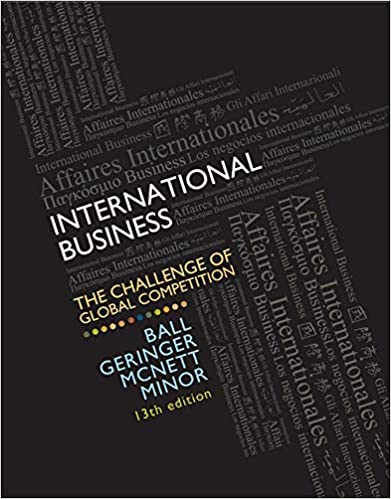
International Business 13th Edition by Donald Ball,Michael Geringer,Michael Minor ,Jeanne McNett
Edition 13ISBN: 978-0077606121
International Business 13th Edition by Donald Ball,Michael Geringer,Michael Minor ,Jeanne McNett
Edition 13ISBN: 978-0077606121 Exercise 5
GlobalSoft: Profiting from International Transfer Pricing
GlobalSoft Inc. is a leading competitor in the international computer software industry. The company is headquartered in the United States and has subsidiaries in more than 100 nations of the world. More than 80 percent of Global-Soft's long-lived assets are located in the United States, and 60 percent of its revenues of $58 billion are generated from the U.S. operations. However, 60 percent of the company's $25 billion of income before taxes is generated in international markets, with much of that coming from nations with corporate tax rates that are much lower than the 35 percent tax rate that GlobalSoft is subject to in the United States.
One way that GlobalSoft has reduced the level of taxes that it pays is through the careful use of transfer pricing. For example, the company established a subsidiary in Ireland, where the corporate tax rate in 2011 was only 12.5 percent, one of the lowest levels in Europe. This subsidiary, called Emerald Isle Enterprises (EIE), serves as the regional headquarters for the licensing of GlobalSoft's software to European customers. Although most of GlobalSoft's software development occurs in the United States, the American organization then licenses this software at a relatively low rate to EIE. The outcome of this transfer pricing decision is that a lower level of revenues-and corresponding taxable income-is earned by GlobalSoft's American operations from EIE's activities. As a result, GlobalSoft pays a smaller amount of taxes in the United States than would be the case if it charged a higher license fee to EIE.
Although EIE licenses GlobalSoft's software from its parent company at a relatively low percentage rate, EIE charges a much higher fee to GlobalSoft's other European subsidiaries for this software. This approach to pricing allows EIE to have a high level of revenues and taxable income in Ireland, where the tax rate is low. The high license fee also reduces the level of taxable income in the other European subsidiaries, which are located in nations that charge higher tax rates than Ireland. Due to tax treaties, the after-tax profits of EIE are not subject to further taxation when they are transferred to the company's headquarters in the United States.
Through the creative use of transfer pricing techniques such as this, it is estimated that GlobalSoft has been able to reduce its worldwide tax bill by more than $500 million per year.
If you were a shareholder in GlobalSoft, would you be supportive of the company's approach to transfer pricing? Why or why not?
GlobalSoft Inc. is a leading competitor in the international computer software industry. The company is headquartered in the United States and has subsidiaries in more than 100 nations of the world. More than 80 percent of Global-Soft's long-lived assets are located in the United States, and 60 percent of its revenues of $58 billion are generated from the U.S. operations. However, 60 percent of the company's $25 billion of income before taxes is generated in international markets, with much of that coming from nations with corporate tax rates that are much lower than the 35 percent tax rate that GlobalSoft is subject to in the United States.
One way that GlobalSoft has reduced the level of taxes that it pays is through the careful use of transfer pricing. For example, the company established a subsidiary in Ireland, where the corporate tax rate in 2011 was only 12.5 percent, one of the lowest levels in Europe. This subsidiary, called Emerald Isle Enterprises (EIE), serves as the regional headquarters for the licensing of GlobalSoft's software to European customers. Although most of GlobalSoft's software development occurs in the United States, the American organization then licenses this software at a relatively low rate to EIE. The outcome of this transfer pricing decision is that a lower level of revenues-and corresponding taxable income-is earned by GlobalSoft's American operations from EIE's activities. As a result, GlobalSoft pays a smaller amount of taxes in the United States than would be the case if it charged a higher license fee to EIE.
Although EIE licenses GlobalSoft's software from its parent company at a relatively low percentage rate, EIE charges a much higher fee to GlobalSoft's other European subsidiaries for this software. This approach to pricing allows EIE to have a high level of revenues and taxable income in Ireland, where the tax rate is low. The high license fee also reduces the level of taxable income in the other European subsidiaries, which are located in nations that charge higher tax rates than Ireland. Due to tax treaties, the after-tax profits of EIE are not subject to further taxation when they are transferred to the company's headquarters in the United States.
Through the creative use of transfer pricing techniques such as this, it is estimated that GlobalSoft has been able to reduce its worldwide tax bill by more than $500 million per year.
If you were a shareholder in GlobalSoft, would you be supportive of the company's approach to transfer pricing? Why or why not?
Explanation
Transfer pricing refers to the process o...
International Business 13th Edition by Donald Ball,Michael Geringer,Michael Minor ,Jeanne McNett
Why don’t you like this exercise?
Other Minimum 8 character and maximum 255 character
Character 255


